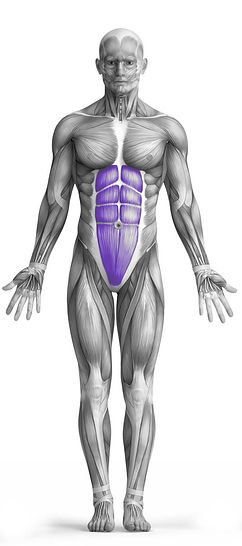Loaded To Unloaded Beast 101 Video Tutorial
0

Exercise Synopsis
Target Muscle Group
Abs
Secondary Targets
Execution
Compound
Force Type
Core
Required Equipment
Bodyweight
Fitness Level
Intermediate
Variations
None
Alternatives
None
Timer
Hour
Minute
Second
Stopwatch
00:00:00:00
Overview
The Loaded To Unloaded Beast is a dynamic bodyweight exercise that primarily targets the abs while also engaging the shoulders. In this exercise, the individual starts in a plank position with their hands placed on the ground directly under their shoulders and their feet on sliders or a towel. From this position, they engage their core muscles to lift their hips towards the ceiling, transitioning into an inverted pike position. As they do so, they simultaneously slide their feet forward while keeping their arms straight, creating a loaded position for the abs. Then, they reverse the movement, sliding their feet back to the starting plank position, thus unloading the abs. This exercise challenges the core stability and strength while also engaging the shoulders for stabilization, providing a comprehensive workout for the upper body.
How to Perform
Start in a plank position with your hands placed directly under your shoulders and your feet on sliders or a towel, ensuring your body forms a straight line from head to heels.
Engage your core muscles to stabilize your body and prevent your hips from sagging or lifting too high.
Begin the movement by lifting your hips towards the ceiling, transitioning into an inverted pike position.
Simultaneously, slide your feet forward towards your hands while keeping your arms straight, creating a loaded position for the abs.
Pause briefly at the top of the movement, focusing on squeezing your abs and maintaining stability.
Slowly reverse the movement by sliding your feet back to the starting plank position while lowering your hips towards the ground.
Ensure a controlled descent to engage the abs and prevent any sudden movements that may strain the lower back.
Repeat the movement for the desired number of repetitions, focusing on maintaining proper form and control throughout.
Keep your shoulders stabilized and avoid shrugging or collapsing them during the movement to engage the shoulder muscles effectively.
Focus on breathing rhythmically throughout the exercise, exhaling as you lift your hips and slide your feet forward, and inhaling as you lower your hips and slide your feet back.
Gradually increase the difficulty of the exercise by sliding your feet further forward or performing the movement at a slower tempo.
As you become more proficient, you can also experiment with variations such as adding a push-up at the bottom of the movement or holding the pike position for an extra challenge.
After completing the set, take a moment to stretch and relax the muscles, focusing on deep breathing to promote recovery and prevent muscle tightness or soreness.
★ Bonus: For exercises that involve external weights (such as dumbbells, barbells, or machines), the One Rep Max (1RM) calculator can help you estimate your maximum lifting capacity. Use it to track your strength progress and adjust your training for optimal results.
Tips
Start in a plank position with hands under shoulders and feet on sliders or towel.
Engage core muscles to stabilize body and prevent hips from sagging.
Lift hips towards ceiling, transitioning into an inverted pike position.
Simultaneously, slide feet forward towards hands while keeping arms straight.
Pause at the top, focusing on squeezing abs and maintaining stability.
Reverse the movement by sliding feet back to starting plank position.
Lower hips towards ground with controlled descent to engage abs.
Maintain stable shoulders throughout the movement, avoiding shrugging.
Breathe rhythmically, exhaling as hips lift and feet slide forward.
Gradually increase difficulty with variations such as push-ups or longer holds.
How Not to Perform
Avoid letting your hips sag or lift too high during the plank position; maintain a straight line from head to heels to effectively engage the abs and prevent strain on the lower back.
Do not rush through the movement; perform each transition with controlled movements to maximize muscle engagement and prevent jerky movements that can lead to injury.
Avoid collapsing your shoulders or shrugging during the exercise; keep them stabilized and squared to the ground to effectively engage the shoulder muscles and prevent strain.
Do not slide your feet too quickly or forcefully; focus on smooth and controlled movements to target the abs and prevent unnecessary strain on the hip flexors.
Avoid holding your breath; remember to breathe rhythmically throughout the exercise to maintain energy levels and optimize oxygen flow to the muscles.
Do not forget to engage your core muscles throughout the entire movement; focus on contracting the abs to stabilize your body and support the transitions.
Avoid arching or rounding your back during the movement; maintain a neutral spine alignment to prevent strain on the lower back and maximize effectiveness.
Do not neglect proper warm-up and stretching before performing the exercise; this helps prepare your muscles for the workout and reduce the risk of injury.
Avoid overextending your arms or locking out your elbows; keep them slightly bent to prevent strain on the joints and maintain muscle engagement.
Do not perform the exercise if you experience pain or discomfort; listen to your body and stop if necessary to prevent injury and ensure safety.
Variations
Variations of fitness exercises refer to different ways of performing a specific exercise or movement to target various muscle groups, intensities, or goals. These variations aim to challenge the body differently, prevent plateaus, and cater to individuals with varying fitness levels.
Alternatives
Alternative exercises in fitness refer to different movements or activities that target similar muscle groups or serve the same training purpose as the primary exercise. These alternative exercises can be used as substitutes when the original exercise is unavailable or challenging to perform due to various reasons such as equipment limitations, injuries, or personal preferences.








